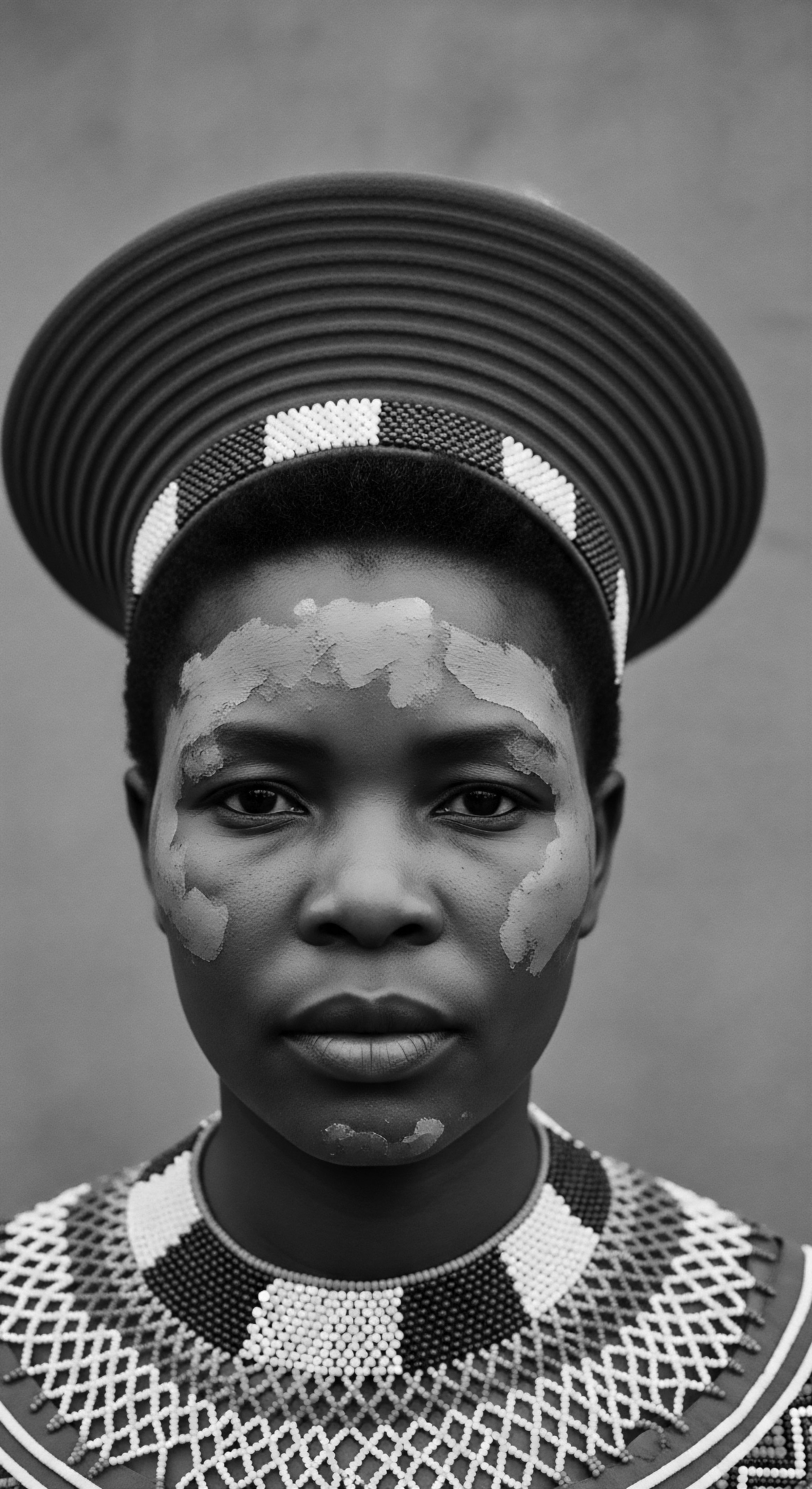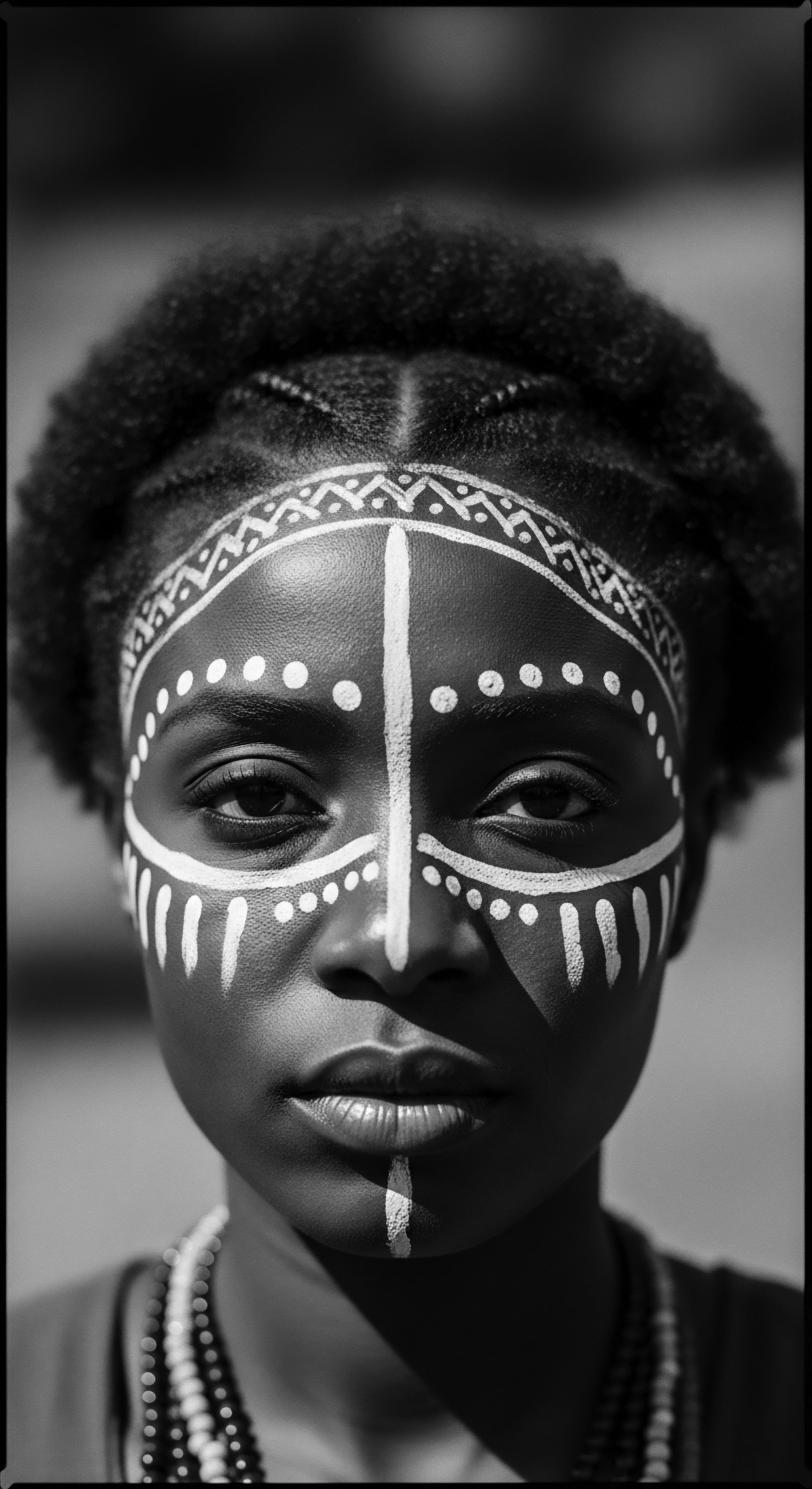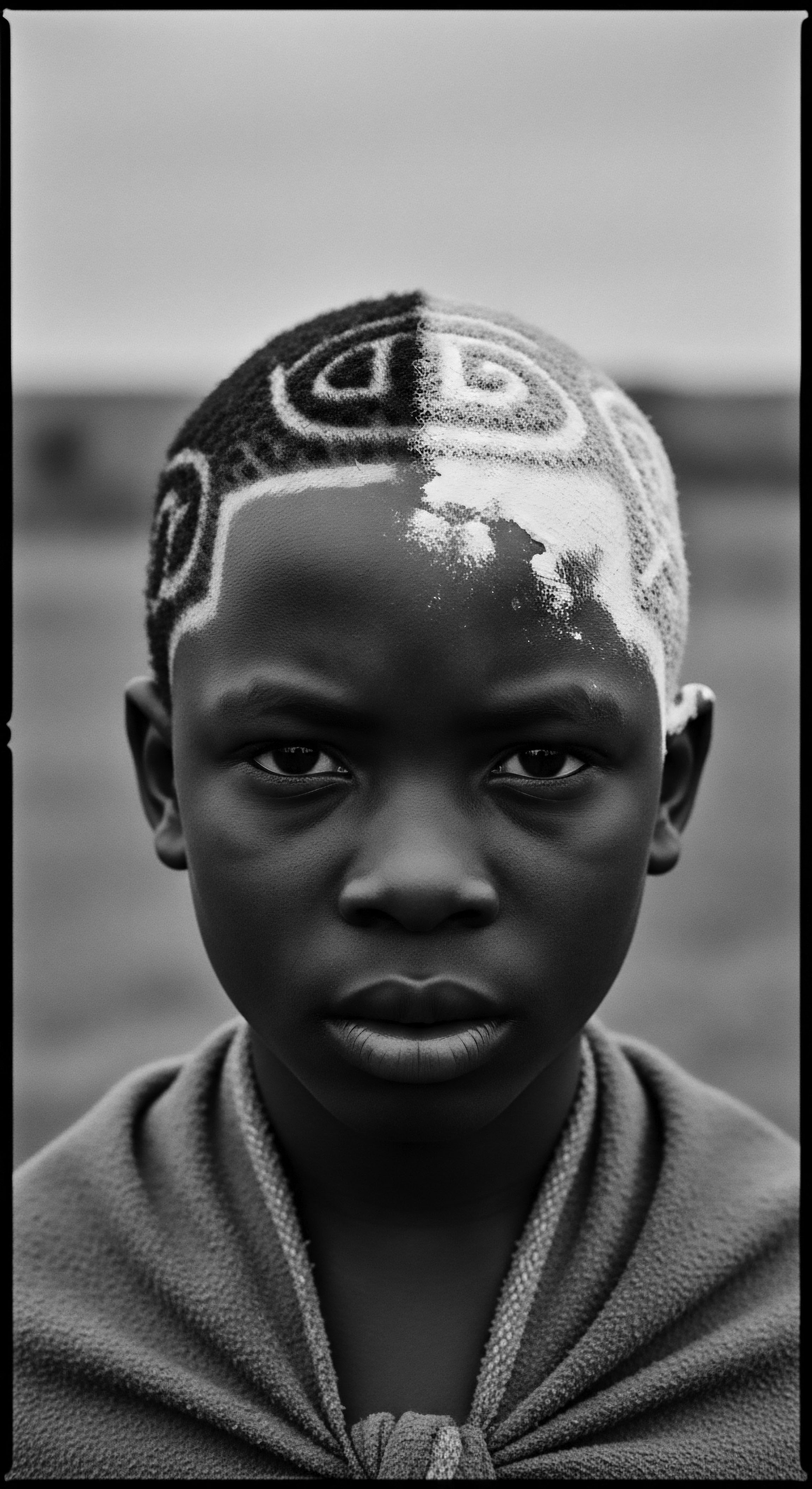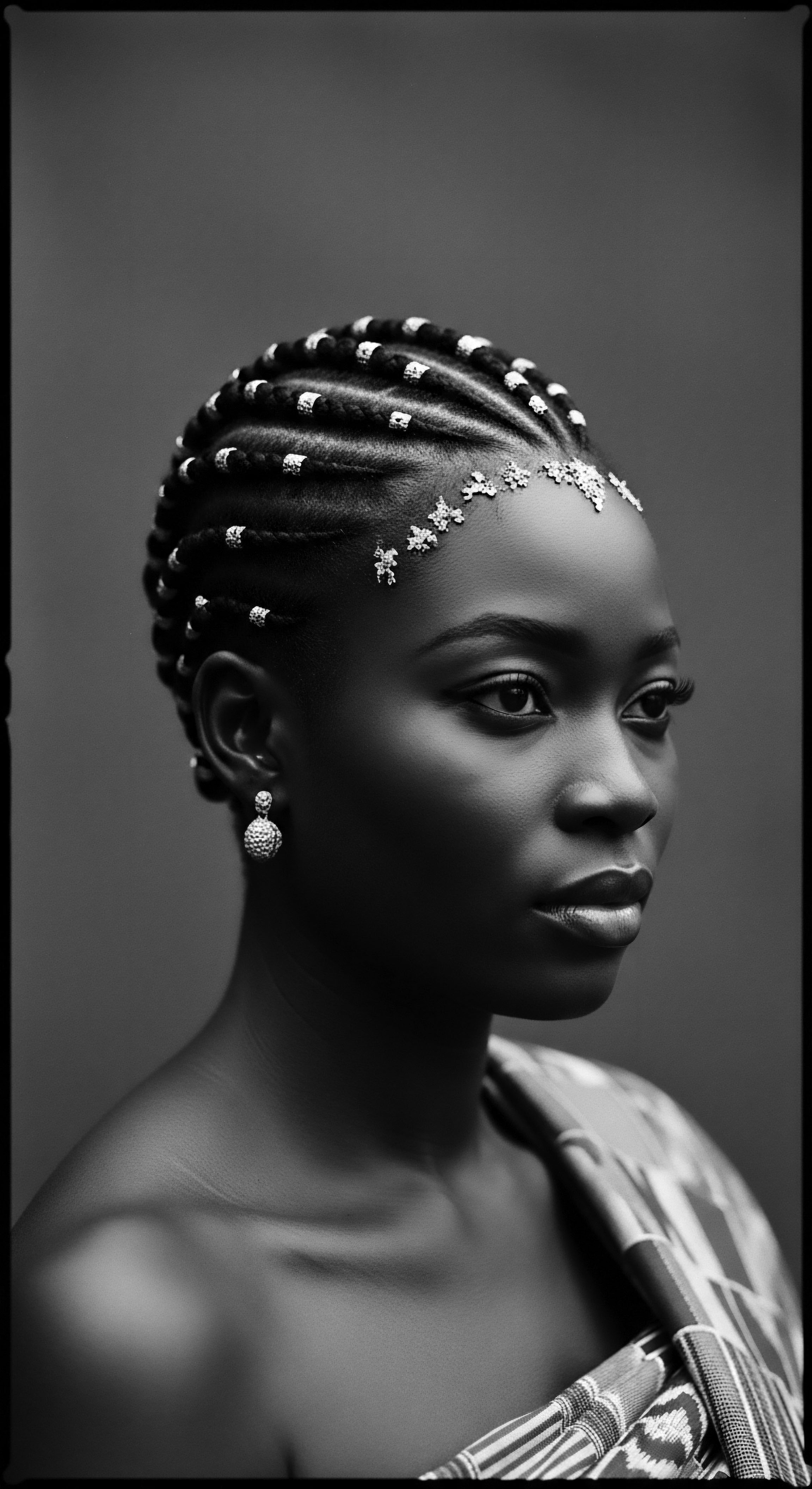
Roots
There are narratives etched not in parchment or stone, but within the very coils and curves of our textured hair. These are stories of enduring wisdom, passed down through generations, speaking of connection to the land and to those who walked before us. To understand the profound relationship between Black Soap and the identity held within textured strands, we must return to the source, to the verdant heartlands of West Africa where this remarkable cleanser first took form. It is in the genesis of this soap that we discover not just a cleansing agent, but a sacred artifact, a testament to ancestral ingenuity and a deep reverence for natural order.

Ancestral Origins of a Cleansing Legacy
The journey of Black Soap, known widely as Ose Dudu among the Yoruba people of Nigeria, and Alata Samina in Ghana, began centuries ago, born from a harmony of readily available botanicals and profound knowledge of their properties. This was not a product conceived in laboratories, but meticulously crafted by hands that understood the rhythms of the earth. Its creation involved the careful collection and sun-drying of plantain skins, cocoa pods, and sometimes palm tree leaves or shea tree bark.
These organic materials were then roasted to a precise ash, a process that required a knowing eye and steady hand to attain the perfect mineral content. This ash, steeped in water, became the potent alkaline solution that would saponify with a blend of tropical oils—often palm kernel oil, coconut oil, and the deeply nourishing Shea Butter.
Each ingredient contributed a specific quality, understood through centuries of observation and practice. The plantain skins, rich in potassium, provided a gentle exfoliation. Cocoa pods contributed antioxidants. Shea butter, a gift from the Vitellaria paradoxa tree, bestowed profound moisturizing qualities, shielding the hair and scalp from harsh elements.
This ancestral alchemy transformed raw plant matter into a cleansing medium that went beyond mere hygiene; it was a conduit for wellness, a ritualistic purification that honored the body as an extension of the earth. The very act of preparing the soap was, in itself, a heritage practice, often undertaken by women, reinforcing communal bonds and passing down vital knowledge. (Oyekanmi et al. 2014)

What Elemental Biology Informs Black Soap’s Ancestral Effectiveness?
The efficacy of traditional Black Soap on textured hair can be seen through lenses both ancient and contemporary. Ancestors, without modern microscopes, recognized the profound impact of these natural compounds on the hair’s resilience and cleanliness. Today, we observe that the alkaline nature derived from the plant ash helps to open the hair cuticle, allowing for deep cleansing of product buildup, environmental pollutants, and excess sebum. Simultaneously, the saponified oils provide a natural emollient action, ensuring strands are purified without being stripped bare of their inherent moisture.
The gentle, yet effective, cleansing power of Black Soap creates a suitable environment for textured hair, which by its very structure tends to be more prone to dryness and requires careful moisture retention. Its rich content of naturally occurring vitamins A and E also supports scalp health and hair strength.
Consider the delicate architecture of textured hair, often characterized by its unique coiling patterns and porous nature. This morphology demands a cleanser that respects its integrity, one that lifts impurities without compromising the hair’s natural lipid barrier. The traditional formulation of Black Soap does precisely this.
It provides a purifying action that honors the hair’s inherent structure, allowing subsequent conditioning and moisturizing agents to penetrate effectively. This ancient wisdom, validated by contemporary understanding of hair biology, highlights a continuum of care that has always placed the health and vitality of textured strands at its core.
Black Soap’s profound connection to textured hair identity begins with its ancestral origins, a testament to deep botanical knowledge and communal craft.

Language and Meaning in Hair Heritage
The names themselves—Ose Dudu and Alata Samina—carry narratives of cultural exchange and identity. “Ose” means soap, and “dudu” signifies black in Yoruba, directly describing its appearance. “Alata Samina” in Ghana translates to “pepper trader’s soap,” believed to reference the Yoruba women traders who introduced it to the Akan people. These names are more than mere labels; they are linguistic artifacts that document the historical movements of people, ideas, and trade across West Africa.
They tell of communities sharing practices, adapting traditions, and co-creating a shared heritage of care. The language surrounding hair in these communities often reflects its elevated status, speaking to its role as a visible marker of identity, status, and spirituality. In many West African societies, hairstyles communicated age, marital status, ethnic identity, religion, wealth, and rank within the community.
- Ose Dudu ❉ The Yoruba term for Black Soap, translating simply to “black soap.”
- Alata Samina ❉ The Ghanaian term, meaning “pepper trader’s soap,” referencing its historical introduction.
- Botanical Alchemy ❉ The traditional practice of transforming plant matter into a potent cleanser.
This lexicon grounds the product in its heritage, reminding us that its very nomenclature is steeped in cultural meaning. It reinforces the idea that hair care was never a superficial pursuit. Instead, it was an integral thread in the fabric of social and spiritual life, with Black Soap playing a foundational role in maintaining both physical cleanliness and cultural connection.

Ritual
From its deep origins, Black Soap transcended its practical purpose, evolving into a central element within the ancestral rituals of textured hair care. These were not isolated acts of cleansing; they were communal ceremonies, moments of profound connection that bound individuals to their families, their communities, and their spiritual lineages. The application of Black Soap was often accompanied by storytelling, shared laughter, and lessons imparted across generations, transforming a simple wash day into a potent act of cultural preservation. The tender hands that worked the rich lather through coils and curls were not simply detangling strands; they were weaving a continuous narrative of identity and belonging.

How Did Ancestral Cleansing Rituals Shape Textured Hair Care?
In pre-colonial West Africa, hair care was a deeply social activity. Communal grooming served as a vital means of strengthening familial bonds and fostering a sense of collective identity. The act of cleansing with Black Soap, often outdoors under the warm sun, became a meditative practice, a time for women to share wisdom, impart life lessons, and connect with the younger generation. The physical cleansing of hair was intertwined with spiritual purification.
Many ancient African communities held a strong belief that the head served as a spiritual portal, a sacred entry point for divine energy and communication with ancestors. Therefore, the cleansing of hair was not merely about removing dirt; it was about honoring this sacred connection, preparing the individual for spiritual receptivity and ensuring harmony with the ancestral realm.
The very process of applying Black Soap often involved a gentle yet thorough massage of the scalp, stimulating circulation and encouraging healthy hair growth, a practice well-regarded today. The tactile sensation of the raw, naturally grainy soap against the skin and scalp was part of the experience, a reminder of its earthy origins. This ritualistic engagement with one’s hair and scalp went beyond surface-level care, addressing holistic wellbeing, a principle deeply rooted in ancestral wisdom. The consistent use of natural ingredients, derived directly from the land, meant that these rituals were also acts of deep ecological respect, living in reciprocity with the environment that provided such bounty.

The Living Traditions of Black Soap and Hair Cleansing
The traditions surrounding Black Soap for hair care persist in various forms today, a testament to their enduring power and efficacy. While modern lifestyles may have shifted some of the communal aspects, the core principles of holistic care and deep cleansing remain. Families, particularly mothers and daughters, continue to share knowledge about using Ose Dudu or Alata Samina to maintain the health and vitality of textured hair. This continuity represents a living archive of practice, adapting through time while retaining its essential spirit.
The traditional method for creating Black Soap involves meticulous steps, often passed down within specific communities or families. The careful collection of raw plant materials is followed by a precise roasting process, turning plantain skins and cocoa pods into nutrient-rich ash. This ash is then mixed with water, creating a lye solution, which is then combined with fats like Palm Kernel Oil, Shea Butter, and Coconut Oil.
The mixture undergoes a slow saponification over several hours, often tended over an open fire. The resulting product is a soft, pliable soap, rich in minerals and beneficial fatty acids.
| Traditional Ingredient Plantain Skins |
| Ancestral Benefit for Hair Purification, gentle exfoliation of scalp, mineral supply. |
| Modern Scientific Understanding Rich in potassium and antioxidants, assists in removing dead skin cells and environmental buildup without harshness. |
| Traditional Ingredient Cocoa Pod Ash |
| Ancestral Benefit for Hair Deep cleansing, skin conditioning, ancestral wisdom saw it as enhancing vitality. |
| Modern Scientific Understanding Provides gentle exfoliation, helps in cleansing pores and promoting a clearer scalp environment. |
| Traditional Ingredient Shea Butter |
| Ancestral Benefit for Hair Moisture, protection, softness, traditional belief in strengthening strands. |
| Modern Scientific Understanding A natural emollient, deeply moisturizes, reduces breakage, and provides vitamins A and E. |
| Traditional Ingredient Palm Kernel Oil |
| Ancestral Benefit for Hair Nourishment, conditioning, used for healthy hair appearance. |
| Modern Scientific Understanding Contains fatty acids and antioxidants that condition the hair, contributing to shine and softness. |
| Traditional Ingredient These ancestral ingredients work synergistically, offering a heritage-rich approach to hair and scalp health. |
Communal hair cleansing with Black Soap was a sacred act, weaving together physical purification with spiritual connection and shared wisdom.
The versatility of Black Soap also allowed for its use in addressing specific hair and scalp concerns within traditional care regimens. For those experiencing scalp irritation or dryness, the soothing properties of the soap’s natural ingredients offered relief. Its ability to deeply cleanse without stripping was particularly valuable for textured hair, which can be delicate and prone to tangling when harshly treated. This made it a cornerstone for maintaining not just the appearance of hair, but its fundamental health, ensuring strands were prepared for traditional styling techniques like braiding and twisting, which are also deeply tied to cultural expression and protection.
The continued practice of using Black Soap in hair care, from individual routines to collective moments, demonstrates the enduring power of ancestral wisdom. It shows how traditional knowledge, honed over centuries, remains relevant and profoundly beneficial for contemporary textured hair identities, offering a deep connection to a legacy of authentic care.

Relay
The journey of Black Soap and its connection to textured hair identity extends beyond ancient practices, reaching into the ongoing story of Black and mixed-race experiences. It forms a powerful symbolic and practical link across the diaspora, acting as a tangible connection to ancestral lands and a declaration of selfhood. The resilience of this humble cleanser mirrors the enduring strength of the communities who have carried its legacy forward, often against immense historical pressures that sought to dismantle their cultural ties and inherent beauty. Its history is not merely a tale of ingredients and uses, but a chronicle of survival, reclamation, and enduring pride in heritage.

The Historical Imperative of Hair Identity
During the transatlantic slave trade, one of the most dehumanizing acts inflicted upon enslaved Africans was the forced shaving of their heads upon arrival in the Americas. This act was a deliberate attempt to strip individuals of their cultural identity, to sever their spiritual connections, and to erase the profound social meanings embedded in their diverse hairstyles. In their homelands, hair was a marker of age, marital status, tribal affiliation, and even spiritual insight, often tended with elaborate care and communal rituals.
The brutal conditions of enslavement severely limited access to traditional hair care tools and ingredients like those used in Black Soap production. Enslaved people were forced to innovate, often using rudimentary substances such as axle grease or bacon fat to attempt to manage their hair, a testament to their unwavering spirit and determination to maintain some semblance of their former selves. (Byrd and Tharps, 2001, p. 25) This period illustrates a stark departure from the holistic, heritage-rich practices of Africa, yet also highlights the tenacity with which Black communities clung to their hair as a symbol of identity, even in the face of profound oppression.
The persistence of hair care traditions, even in adapted forms, became an act of quiet resistance. The communal aspects of hair styling, though modified, continued to provide spaces for connection, solace, and the clandestine passing down of cultural wisdom. The knowledge of ingredients and their benefits, even if substitutions were necessary, was carried in the collective memory, waiting for opportunities to re-emerge and reshape practices. This unbroken chain of knowledge, however strained, ensured that the spirit of ancestral hair care, including the principles embodied by Black Soap, would survive and eventually flourish anew.

Connecting Ancestral Knowledge to Modern Understanding
Today, the resurgence of interest in Black Soap and other traditional African ingredients reflects a broader movement within Black and mixed-race communities to reclaim their hair heritage. This movement is a vibrant intersection of ancestral wisdom, scientific inquiry, and cultural affirmation. Modern science now provides a deeper understanding of why these traditional practices were so effective, validating the intuitive knowledge of past generations. The unique chemical composition of Black Soap, with its natural saponins and nutrient-rich ash, is recognized for its ability to cleanse gently yet effectively, a property particularly beneficial for the delicate nature of textured hair.
The appreciation for Black Soap extends beyond its functional benefits; it represents a commitment to self-acceptance and a rejection of Eurocentric beauty standards that historically marginalized textured hair. By choosing traditional cleansers, individuals are not simply washing their hair; they are participating in a conscious act of cultural memory, aligning themselves with generations of ancestors who also honored their coils and curls. This alignment fosters a sense of pride and connection, deepening personal identity through a tangible link to heritage.
- Cultural Reclamation ❉ The act of re-engaging with traditional practices to assert identity.
- Diasporic Connection ❉ How ancestral practices bridge geographic and temporal divides.
- Ingredient Efficacy ❉ The scientific validation of long-standing traditional wisdom.
The ongoing dialogue between traditional knowledge and contemporary science continues to shape the future of textured hair care. Researchers explore the precise mechanisms by which ingredients like shea butter or plantain ash contribute to hair health, while wellness advocates share methods for incorporating traditional products into modern routines. This collaborative spirit ensures that the legacy of Black Soap remains dynamic and relevant, serving as a constant reminder of the inherent beauty and resilience of textured hair.
| Aspect of Black Soap Use Cleansing Purpose |
| Ancestral Perspective Spiritual and physical purification, preparing for ritual. |
| Contemporary Heritage Reflection Deep, gentle cleansing that honors natural hair structure. |
| Aspect of Black Soap Use Ingredient Sourcing |
| Ancestral Perspective Direct from local botanicals, understanding plants' energies. |
| Contemporary Heritage Reflection Prioritizing natural, ethically sourced ingredients. |
| Aspect of Black Soap Use Application Method |
| Ancestral Perspective Communal bathing, gentle scalp massage, storytelling. |
| Contemporary Heritage Reflection Mindful self-care rituals, connecting to ancestral practices. |
| Aspect of Black Soap Use Symbolic Meaning |
| Ancestral Perspective Connection to land, ancestors, group identity. |
| Contemporary Heritage Reflection Empowerment, cultural pride, reclamation of beauty standards. |
| Aspect of Black Soap Use Black Soap, across centuries, remains a powerful emblem of identity and continuity for textured hair. |
Black Soap’s enduring use signifies a powerful act of reclaiming heritage and reinforcing textured hair identity across generations and geographies.

Shaping Futures Through Ancestral Practices?
The ongoing relevance of Black Soap in textured hair care is not merely a nostalgic return to the past; it is a forward-looking practice. By valuing and perpetuating these ancestral rituals, communities are actively shaping a future where textured hair is celebrated in all its forms. This involves educating new generations about the history of their hair, the struggles for its acceptance, and the inherent wisdom embedded in traditional care practices. It is about fostering a profound self-love that begins with honoring one’s unique strands.
The narratives spun around wash day, the careful selection of natural ingredients, and the very act of using Black Soap contribute to a collective identity that is both rooted in history and dynamically evolving. It represents a conscious decision to define beauty on one’s own terms, to embrace the natural textures that echo centuries of resilience and creativity. This continuous relay of knowledge and practice, from ancient hearths to modern bathrooms, ensures that the soul of a strand remains vibrant, strong, and deeply connected to its undeniable heritage.

Reflection
The journey through the ancestral rituals connecting Black Soap to textured hair identity leaves us with a resonant understanding ❉ hair is never merely a physiological attribute. It is a living archive, a repository of history, spirit, and community. From the first careful collection of plantain skins and cocoa pods in West African villages, yielding the potent Ose Dudu or Alata Samina, to the contemporary self-care practices that honor these traditions, we witness a profound and unbroken lineage of care. This is a story of ingenuity that transformed humble botanicals into a cleanser, a purification ritual that nurtured not just the body but the spirit, and a cultural touchstone that tethered individuals to a collective narrative.
The heritage of textured hair, so beautifully mirrored in the story of Black Soap, speaks of resilience. It reminds us of a time when hair rituals were communal acts, deeply interwoven with social structure, spiritual beliefs, and the passing of ancestral wisdom. It also speaks to the profound journey through adversity, where the forced removal of cultural markers like hair became a symbol of dehumanization, yet the spirit of its meaning persisted. Today, the choice to cleanse with Black Soap is an act of reclamation, a conscious affirmation of self, and a deep bow to the generations whose wisdom shaped these enduring practices.
Every lather, every rinse, becomes a moment of connection—a tender thread linking us to the past, grounding us in the present, and shaping a future where textured hair is recognized as the crown of heritage it has always been. It stands as a vibrant testament to the ‘Soul of a Strand,’ acknowledging that the care we give our hair is an extension of the reverence we hold for our entire being and the rich lineage from which we emerge.

References
- Byrd, Ayana D. and Lori L. Tharps. Hair Story ❉ Untangling the Roots of Black Hair in America. St. Martin’s Press, 2001.
- Adeogun, G. Sanni, A. Okoro, I. & Ifeyinwa, F. Ọsẹ Dúdú ❉ Exploring the Benefits of Yoruba Indigenous Black Soap in Southwest, Nigeria. International Journal of Indigenous Knowledge Systems and Development, 1(1), 2020.
- Oyekanmi, A.A. Ayanbode, O.J. & Adeogun, O.J. Women’s Involvement in Indigenous Black Soap (Ose-Dudu) Production and its Contribution to Household Income in Selected Rural Communities of Southwest Nigeria. Journal of Agricultural Extension and Rural Development, 6(8), 2014.
- Ahmed, I.A. Al-Attar, M.N. & Mansour, A.M. Anti-microbial activity of some indigenous plants against common skin pathogens. Journal of Medical Sciences, 5(3), 2005.
- Ajaiyeoba, E.O. & Okwok, J.E. Ethnopharmacological Survey of Herbal Remedies for Treatment of Malaria in Southwestern Nigeria. Journal of Ethnopharmacology, 85(1), 2003.
- Ajose, F.O. Herbal medicine and skin diseases in Nigeria ❉ A review. Journal of Phytotherapy and Pharmacognosy, 1(1), 2007.
- Erinoso, M.O. Lawal, S.N. & Adeogun, O.J. Perceptions and Practices of Traditional Medicine for Skin Ailments among Rural Dwellers in Southwest Nigeria. Journal of Traditional, Complementary and Alternative Medicines, 11(2), 2016.
- Ikpoh, I.S. Ekanem, A.U. & Akpan, E.J. Antimicrobial efficacy of African black soap. African Journal of Clinical and Experimental Microbiology, 13(2), 2012.
